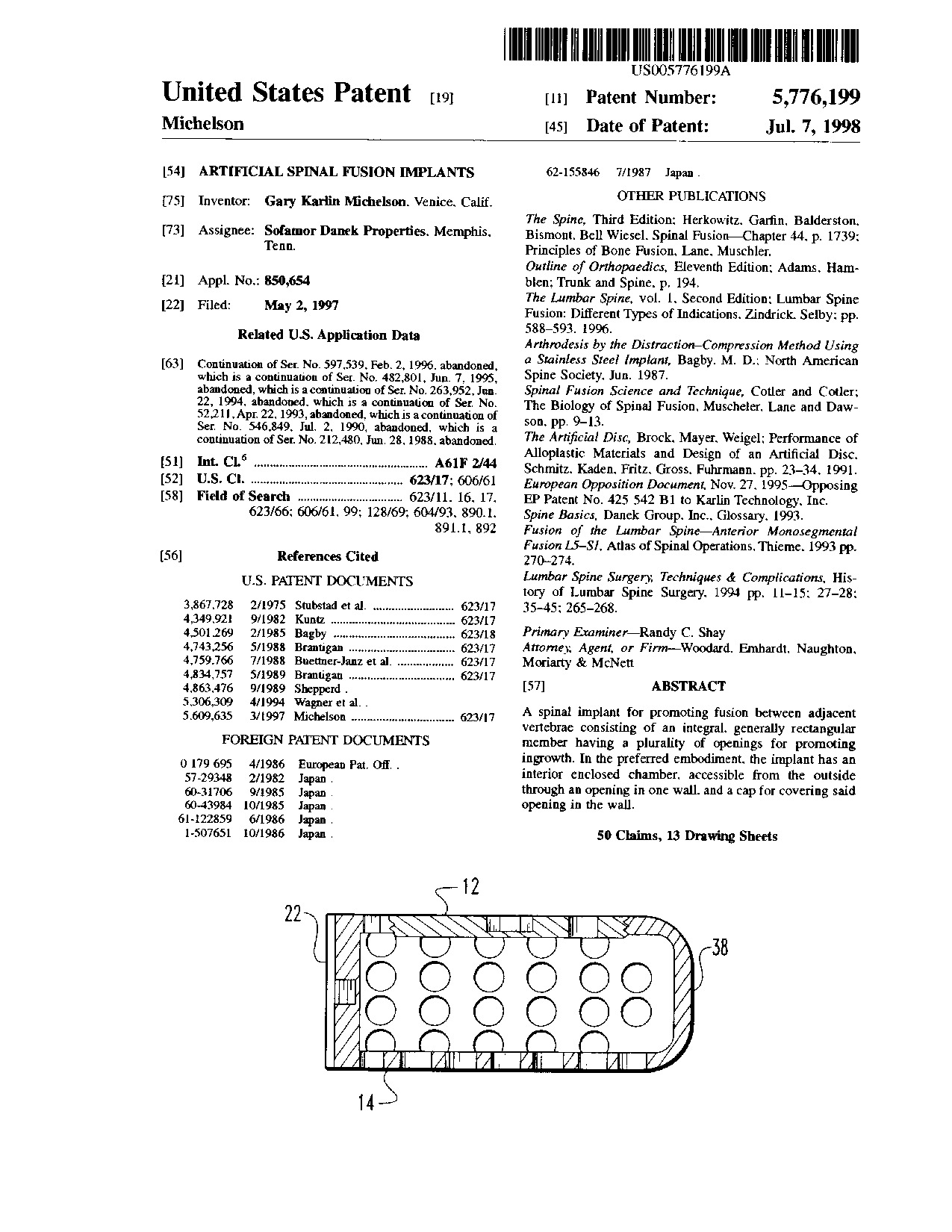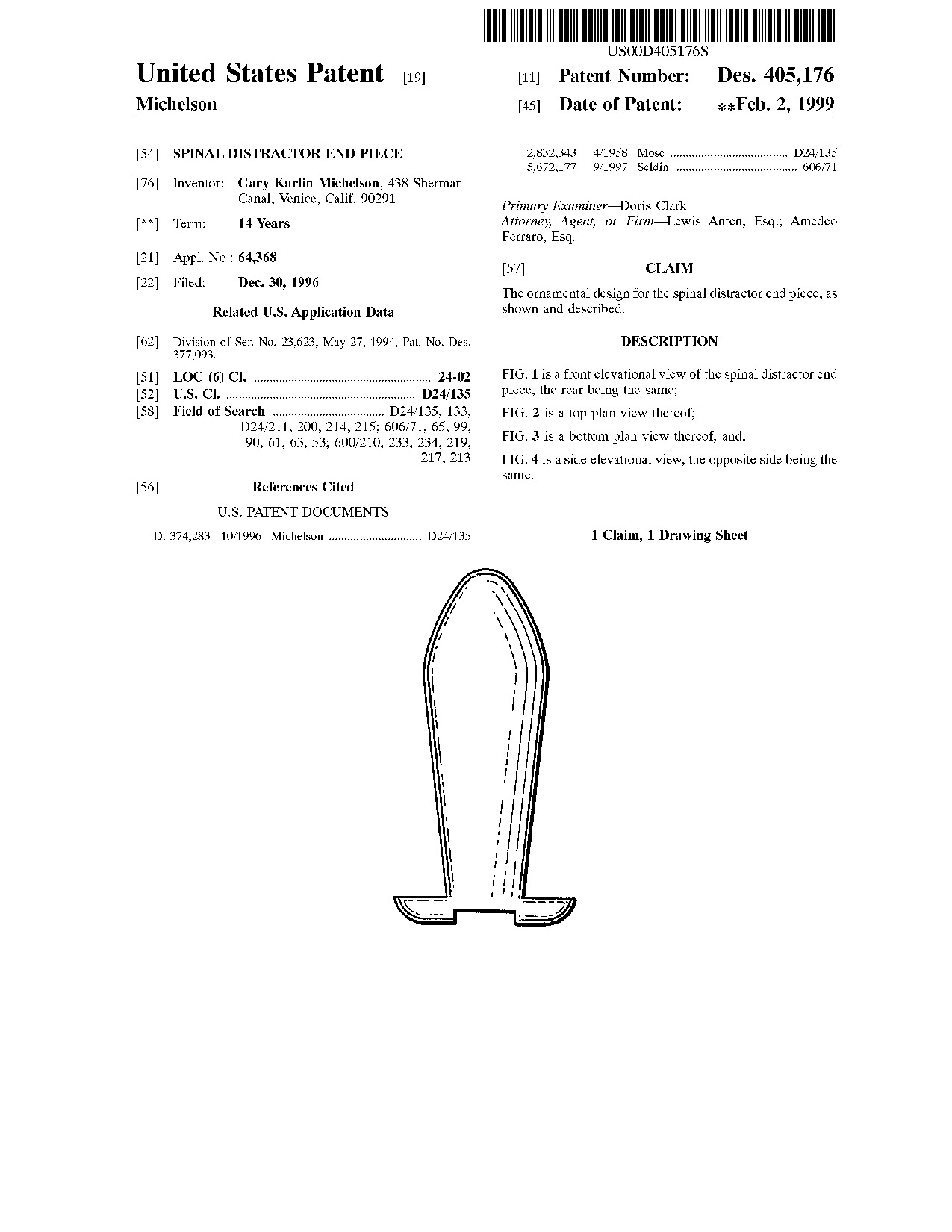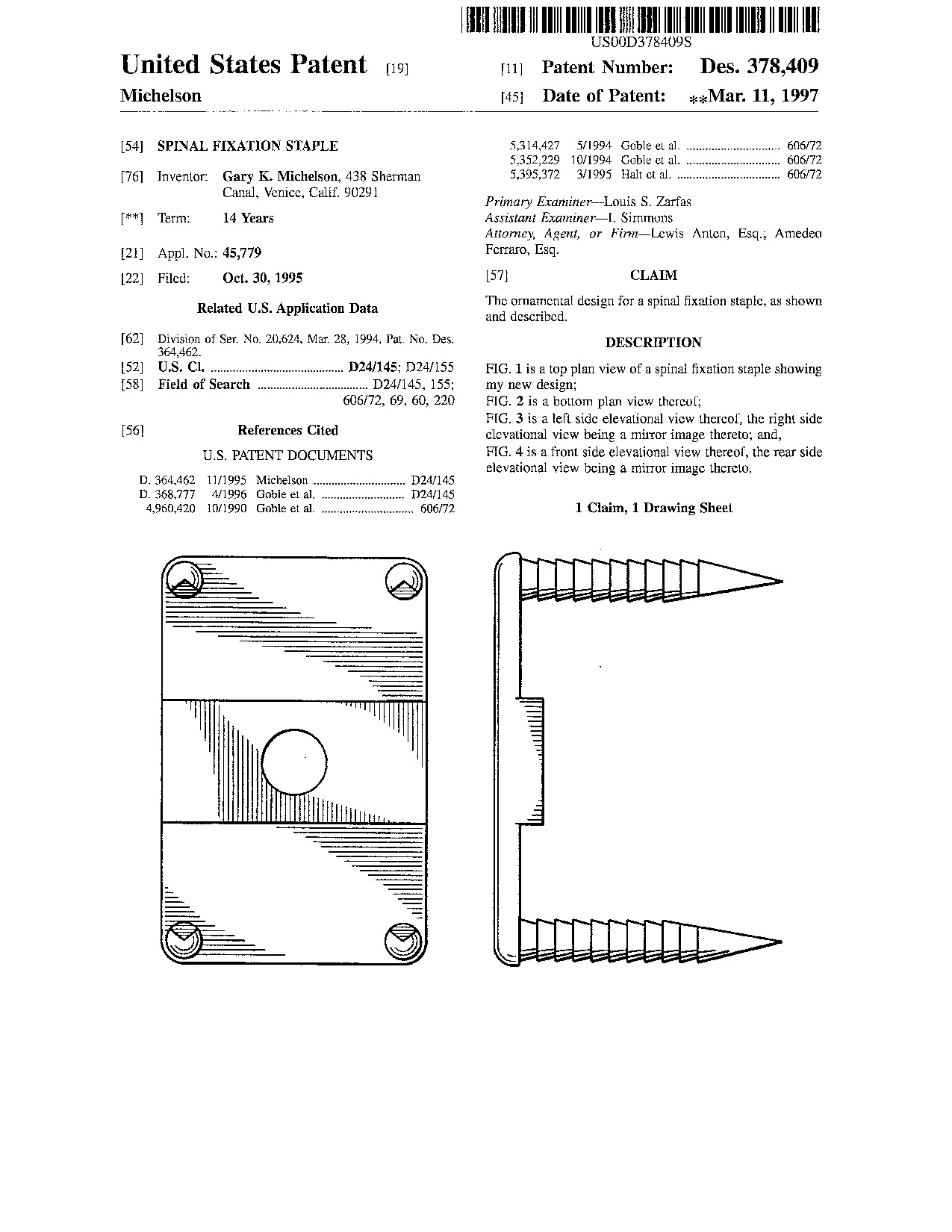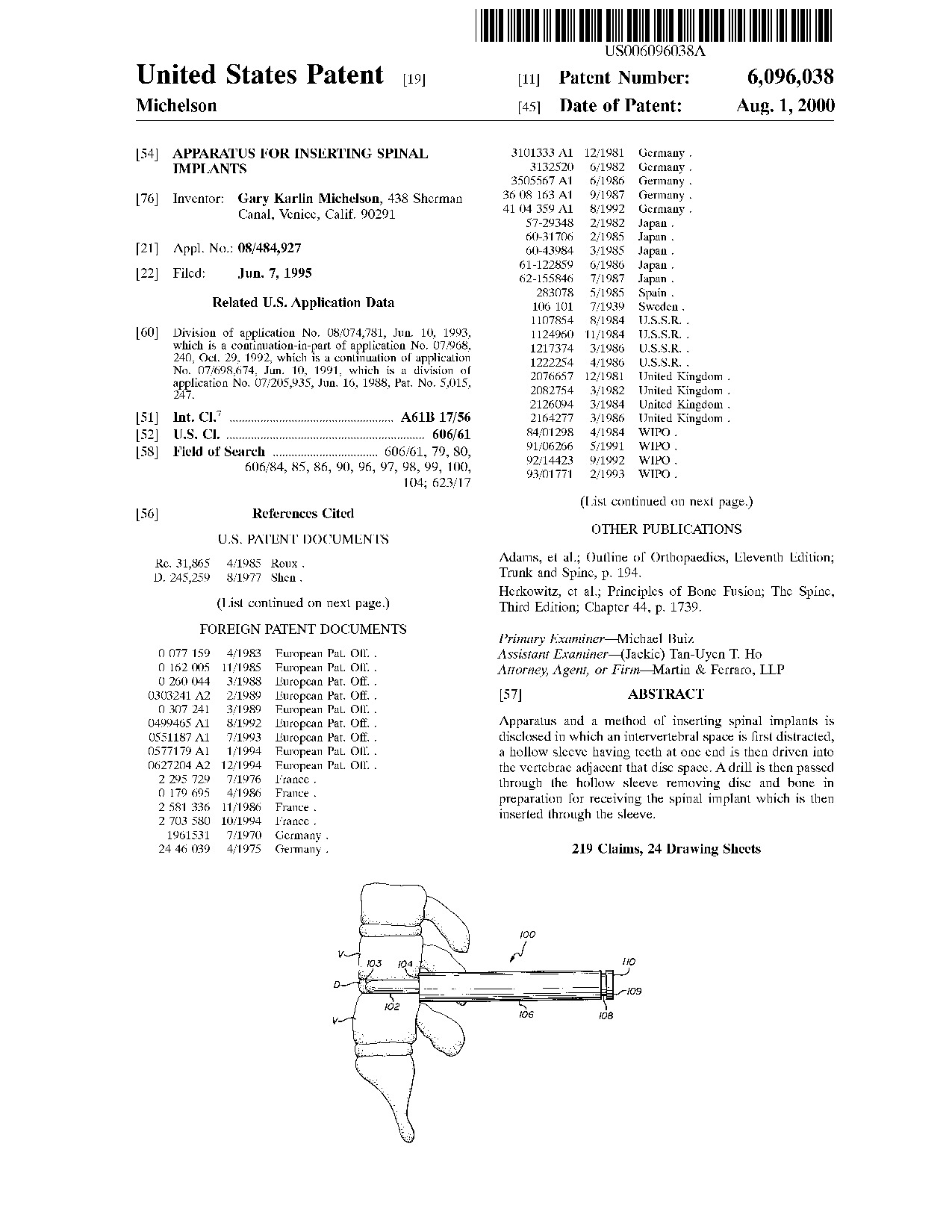Patents Directory for Dr. Gary K. Michelson — U.S. Published Patents only
340 patents found - Page 14
| Patent | Abstract |
|---|---|
 Apparatus instrumentation, and method for spinal fixation - Patent 6,120,503 Apparatus instrumentation, and method for spinal fixation - Patent 6,120,503
|
A spinal fixation device for stabilizing one or more segments of the human spine and for preventing the dislodgement of intervertebral spinal fusion implants, which remains permanently fixated once applied. The spinal fixation device of the present invention comprises of a staple member made of material appropriate for human surgical implantation which is of sufficient length to span the disc space between two adjacent vertebrae and to engage, via essentially perpendicular extending projections, the vertebrae adjacent to that disc space. A portion of the staple of the spinal fixation device interdigitates with an already implanted intervertebral spinal fusion implant which itself spans the disc space to engage the adjacent vertebrae, and the spinal fixation device is bound to the spinal fusion implant by a locking means. The spinal fixation device of the present invention is of great utility in restraining the vertebrae adjacent to the spinal fusion implant from moving apart as the spine is extended and also serves as an anchor for a multi-segmental spinal alignment means for aligning more that one segment of the spine.
|
 Surgical rongeur - Patent 6,142,997 Surgical rongeur - Patent 6,142,997
|
An improved rongeur for cutting bone or cartilage comprising two shaft members capable of reciprocating motion relative to each other wherein one shaft member terminates in a foot plate and the other shaft member comprises a combined cutting element and storage member is disclosed. The combined cutting element and storage member has a cutting edge at its distal end and a storage chamber proximate the cutting edge for collecting and storing cut pieces of bone or cartilage in an amount greater than the maximum bone or cartilage capable of being cut in a single full cut. The combined cutting element and storage member is truly disposable, rather than merely replaceable and requires the use of no tools or special assembly. The rongeur may be manually activated or activated by a solenoid and powered by a battery.
|
 Artificial spinal fusion implants - Patent 5,776,199 Artificial spinal fusion implants - Patent 5,776,199
|
A spinal implant for promoting fusion between adjacent vertebrae consisting of an integral, generally rectangular member having a plurality of openings for promoting ingrowth. In the preferred embodiment, the implant has an interior enclosed chamber, accessible from the outside through an opening in one wall, and a cap for covering said opening in the wall.
|
 Lordotic interbody spinal fusion implants - Patent 6,302,914 Lordotic interbody spinal fusion implants - Patent 6,302,914
|
The present invention is directed to interbody spinal fusion implants having a structural configuration that provides for the maintaining and creating of the normal anatomic angular relationship of two adjacent vertebrae of the spine to maintain and create spinal lordosis. The spinal fusion implants of the present invention are sized to fit within the disc space created by the removal of disc material between two adjacent vertebrae and conform wholly or in part to the disc space created. The spinal fusion implants of the present invention have upper and lower surfaces that form a support structure for bearing against the end plates of the adjacent vertebrae. The upper and lower surfaces are disposed in a converging angular relationship to each other such that the implants of the present invention have an overall "wedged-shape" in an elevational side view. The angular relationship of the upper and lower surfaces places and maintains the vertebrae adjacent to those surfaces in an angular relationship to each other, creating and maintaining the desired lordosis.
|
 Spinal distractor end piece - Patent D405,176 Spinal distractor end piece - Patent D405,176
|
|
 Translateral spinal implant - Patent 5,860,973 Translateral spinal implant - Patent 5,860,973
|
An oversized spinal implant for translateral insertion into the disc space between two vertebrae a length that is greater than one half of the transverse width of the vertebrae and is greater than the depth of the vertebrae. The translateral implant of the present invention has a height that is greater than the height of the disc space between two adjacent vertebrae so as to engage both of the vertebrae. The width of the implant need be only slightly less than the depth of the vertebrae themselves. The translateral spinal fusion implant of the present invention has more surface area of contact and thus permits greater stability so as to withstand torque, and in the case of a threaded implant, increases the depth which any threads are able to penetrate the vertebrae.
|
 Interbody spinal fusion implants - Patent 6,123,705 Interbody spinal fusion implants - Patent 6,123,705
|
The present invention discloses a spinal fusion implant that is at least partially cylindrical, made of material appropriate for human implantation and having preferably, but not necessarily, one closed end and one end capable of being closed, such that an internal chamber can be filled and hold any natural or artificial osteoconductive, osteoinductive, osteogenic, or other fusion enhancing material. The partially cylindrical implant directly participates and is incorporated in the ensuing fusion. In the preferred embodiment, the implant of the present invention relies on surface roughenings of the outer surface to enhance its stability and resist dislodgement from within the disc space between two adjacent vertebrae. The implant of the present invention incorporates at its rear end, an engagement means to facilitate insertion or extraction of the implant. The implant may be filled with, coated with, and/or composed of, fusion promoting substances. Finally, the implant of the present invention does not require rotation for its insertion and can be seated by linear advancement.
|
 Combined distractor and sleeve for inserting spinal implants - Patent D397,436 Combined distractor and sleeve for inserting spinal implants - Patent D397,436
|
|
 Surgical face support - Patent 6,561,194 Surgical face support - Patent 6,561,194
|
The present invention provides a face support device specifically for the purpose of facilitating surgery on humans in the prone position providing for the complete relief of pressure to the areas of the eyes, ears, nose, and mouth of a patient. The face support has a concave curved upper portion, a concave lower surface and a central opening for avoiding pressure on the eyes, nose and lips of the patient, while providing for increased support with decreased pressure and skin shear experienced by the patient's face in contact with the face support.
|
 Milling instrumentation and method for preparing a space between adjacent vertebral bodies - Patent 6,159,214 Milling instrumentation and method for preparing a space between adjacent vertebral bodies - Patent 6,159,214
|
An apparatus and method for placing adjacent vertebrae at a fixed distance and angular relationship relative to each other, fixing said vertebrae in said position by use of a milling block engaging each of said adjacent vertebrae and then using a milling means, the depth, length and excursion of which from side to side are controlled by said apparatus to machine out a defined thickness of bone and a space of defined length, height, width and shape in preparation for receiving an interbody spinal implant or graft of known size and configuration are disclosed.
|
 Artificial spinal fusion implant - Patent D425,989 Artificial spinal fusion implant - Patent D425,989
|
|
 Gooseneck surgical instrument holder - Patent 5,662,300 Gooseneck surgical instrument holder - Patent 5,662,300
|
A gooseneck instrument holder having an instrument holder tip, a gooseneck, a base and a detachable fibre optic light cord is disclosed. The tip, gooseneck, and base are connected by means of a cable which passes through a deflection member in the base. Tension on the cable is adjusted by a detachable handle at the base via a bolt and serves to simultaneously tighten the tip about an instrument, to hold the gooseneck in place, and to hold the base steady so that the holder holds an instrument in place. Very small amounts of turning of the handle is necessary to adequately tighten the holder in place.
|
 Method for inserting spinal implants and for securing a guard to the spine - Patent 6,436,098 Method for inserting spinal implants and for securing a guard to the spine - Patent 6,436,098
|
Apparatus and a method of inserting spinal implants is disclosed in which an intervertebral space is first distracted, a hollow sleeve having teeth at one end is then driven into the vertebrae adjacent that disc space. A drill is then passed through the hollow sleeve removing disc and bone in preparation for receiving the spinal implant which is then inserted through the sleeve.
|
 Spinal fixation staple - Patent D378,409 Spinal fixation staple - Patent D378,409
|
|
 Apparatus for inserting spinal implants - Patent 6,096,038 Apparatus for inserting spinal implants - Patent 6,096,038
|
Apparatus and a method of inserting spinal implants is disclosed in which an intervertebral space is first distracted, a hollow sleeve having teeth at one end is then driven into the vertebrae adjacent that disc space. A drill is then passed through the hollow sleeve removing disc and bone in preparation for receiving the spinal implant which is then inserted through the sleeve.
|
 Lordotic interbody spinal fusion implants - Patent 5,609,635 Lordotic interbody spinal fusion implants - Patent 5,609,635
|
The present invention is directed to interbody spinal fusion implants having a structural configuration that provides for the maintaining and creating of the normal anatomic angular relationship of two adjacent vertebrae of the spine to maintain and create spinal lordosis. The spinal fusion implants of the present invention are sized to fit within the disc space created by the removal of disc material between two adjacent vertebrae and conform wholly or in part to the disc space created. The spinal fusion implants of the present invention have upper and lower surfaces that form a support structure for bearing against the end plates of the adjacent vertebrae. The upper and lower surfaces are disposed in a converging angular relationship to each other such that the implants of the present invention have an overall "wedged-shape" in an elevational side view. The angular relationship of the upper and lower surfaces places and maintains the vertebrae adjacent to those surfaces in an angular relationship to each other, creating and maintaining the desired lordosis.
|
 Apparatus for inserting spinal implants - Patent 5,797,909 Apparatus for inserting spinal implants - Patent 5,797,909
|
Apparatus and a method of inserting spinal implants is disclosed in which an intervertebral space is first distracted, a hollow sleeve having teeth at one end is then driven into the vertebrae adjacent that disc space. A drill is then passed through the hollow sleeve removing disc and bone in preparation for receiving the spinal implant which is then inserted through the sleeve. Apparatus and a method of inserting spinal implants is disclosed in which an intervertebral space is first distracted to restore the normal angular relationship of the vertebrae adjacent to that disc space. An extended outer sleeve having extended portions capable of maintaining the vertebrae distracted in their normal angular relationship is then driven into the vertebrae adjacent that disc space. A drill is then passed through the hollow sleeve removing disc and bone in preparation for receiving the spinal implant which is then inserted through the sleeve.
|
 Interbody spinal fusion implants - Patent 5,785,710 Interbody spinal fusion implants - Patent 5,785,710
|
The present invention discloses a spinal fusion implant that is at least partially cylindrical, made of material appropriate for human implantation and having preferably, but not necessarily, one closed end and one end capable of being closed, such that an internal chamber can be filled and hold any natural or artificial osteoconductive, osteoinductive, osteogenic, or other fusion enhancing material. The partially cylindrical implant directly participates and is incorporated in the ensuing fusion. In the preferred embodiment, the implant of the present invention relies on surface roughenings of the outer surface to enhance its stability and resist dislodgement from within the disc space between two adjacent vertebrae. The implant of the present invention incorporates at its rear end, an engagement means to facilitate insertion or extraction of the implant. The implant may be filled with, coated with, and/or composed of, fusion promoting substances. Finally, the implant of the present invention does not require rotation for its insertion and can be seated by linear advancement.
|
 Method for inserting frusto-conical interbody spinal fusion implants - Patent 6,210,412 Method for inserting frusto-conical interbody spinal fusion implants - Patent 6,210,412
|
The present invention is directed to a method of inserting a variety of interbody spinal fusion implants having at least a partially frusto-conical configuration and the instrumentation and methods by which the implants.
|
 Apparatus and method of inserting spinal implants - Patent 5,505,732 Apparatus and method of inserting spinal implants - Patent 5,505,732
|
Apparatus and a method of inserting spinal implants is disclosed in which an intervertebral space is first distracted, a hollow sleeve having teeth at one end is then driven into the vertebrae adjacent that disc space. A drill is then passed through the hollow sleeve removing disc and bone in preparation for receiving the spinal implant which is then inserted through the sleeve.
|
